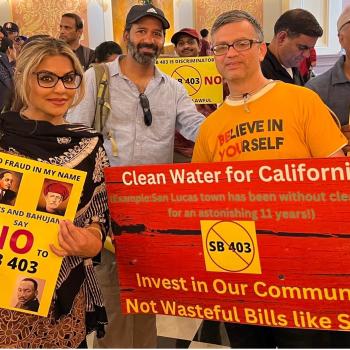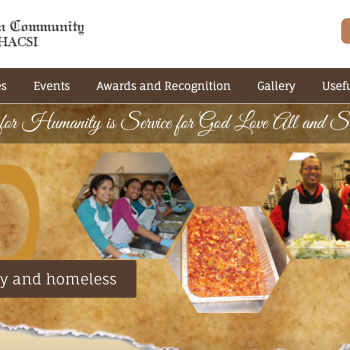I recently watched a video of Hindu- and South Asian American activists showing their support for our Muslim American sisters by wearing hijabs and leading a protest against Islamophobia with strident voices. I was peeved and perhaps even perturbed: it’s an issue that has long sat on my mind, but the images pushed me to find my own voice, to think about attire, and specifically the parallels – or the lack there of – between a sari and a hijab. Donning a sari and the associated red bindi on one’s forehead does seem to be essential to being Hindu, wearing a hijab does seem essential to being Muslim – but the key word is seem. And while both represent how religion and culture are diverse and intertwined, a Hindu wearing a hijab doesn’t strike me as a symbol of solidarity or include the multitude of issues that I saw in the image of a Hindu hijabi.
In spite of my love of the sari – and encouraging non Indian/non Hindu friends to try Indian clothes – I’ve always been concerned about cultural appropriation when I see others wear it. Similarly, is it appropriate for someone who’s not part of the Muslim culture to appropriate a hijab? I’ve seen what happens when someone wears a sari while being completely unfamiliar with the rich tradition that the sari comes from. It could be that she is awkward in the way she carries herself, making the attire go from classy to clownish (and occasionally inappropriate). And in the worst scenario, I’ve had someone gush at me, “I love this costume!” I’ve had to gently and firmly explain that this is not a costume. It comes from a culture wealthy in its textiles and art. The sari is the daily attire of several hundred million women of many social, economic and cultural backgrounds. It is made and draped in a multitude of ways that can leave one flabbergasted at the creativity coming from the tiny landmass of India.
I’ve also had to explain, particularly to visitors at the temple, that the sari is not a religious garment and that one doesn’t need to wear a sari to come to the temple. I sometimes wish I could explain this even to the younger generation of Hindu American women, so that they might feel more comfortable coming in their non-Indian garb – and maybe come more frequently to the mandir, without the added obligation of dressing in clothes that are not necessarily second nature to them. I especially wish I could tell those young women who look down their nose at me when I wear a sari in a mainstream setting, to get with the program. While the sari is not a symbol of the Hindu tradition, I’ve rarely received the same kind of support when I walk into many a setting…where I am representing a Hindu voice on an interfaith panel, attending a fundraising dinner for a local pan-Asian advocacy organization as an advocate for Hindu Americans, or speaking to a university world religions class about Hinduism as a lived tradition, or hosting a church group for a tour of the temple where I have lead outreach efforts for more than a decade. I’m wearing a sari to prove a point: it’s my favorite garment, and by choosing to wear it in a non-Indian setting, I would like the sari to be perceived as American as me, representing the culture I come from and the freedom I have to choose to wear it. While my Muslim American friends may also choose to wear a hijab for similar reasons, I don’t find a Hindu American covering their head and hair to have the same connotation.
So this is the transition from the “peeved” part of my feelings, to what worries me about the hijab-wearing Hindu activists. There are many women in America who choose to wear a hijab, but there are activists who don’t – voices from within who may push beyond what people in the Islamic community want to hear. Their point? They “reject this interpretation that the ‘hijab’ is merely a symbol of modesty and dignity adopted by faithful female followers of Islam,” and further point out this:
This modern-day movement, codified by Iran, Saudi Arabia, Taliban Afghanistan and the Islamic State, has erroneously made the Arabic word hijab synonymous with “headscarf.” This conflation of hijab with the secular word headscarf is misleading. “Hijab” literally means “curtain” in Arabic. It also means “hiding,” ”obstructing” and “isolating” someone or something. It is never used in the Koran to mean headscarf.
Another point of concern is that while an American activist may exercise choice and wear a hijab, there is in fact no choice for Muslim women in many parts of the world about wearing not only a hijab, but a burka, or to be constrained by other limits put on women for the sake of modesty. While in graduate school, I worked with a Pakistani American undergrad, who abandoned head coverings and conservative clothing once free from parental restrictions – as I did my bindi, after being accosted as a “dothead” in a NJ mall. A decade ago, a Muslim leader told me of how she came to embrace wearing a hijab after her middle school daughter started wearing one. More recently, I heard a California-based woman, a fellow panelist at an interfaith event, who doesn’t wear hijab in the West, narrate the story of her pilgrimage to Mecca, going on Haj with her grandmother. She wore garments so that only her one eye showed, and felt empowered by that experience – but chose not to wear it or allow any other restrictions on “what showed” on her return home. I’ve fielded questions with a co-panelist who was a staff member at UMich Dearborn, as we served on a panel about bullying in schools at a Parliament of World Religions satellite event at her campus. I watched a young man – his accent revealed his recent arrival and Arabic background – try to bully her for not wearing a head covering and her strong response: a third generation Muslim immigrant, her grandfather from the Middle East taught her about the Koran, and their interpretation of modesty didn’t necessitate wearing a hijab. Modesty, she said, is in how you carry and conduct yourself, and applies to men and women.
As a community activist, Muslim women like this have inspired me – to stand up for what I believe in, and not sell out, in order to provide a voice for those who have none, be it those whose culture is being appropriated, or those who cannot escape a culture that oppresses them. I will standup for my Muslim American sisters who choose to wear a hijab, but I would go wearing a sari and a bindi – claiming who we are, and what we come from. Sharing a platform wearing while wearing something that represents each of us – that is the solidarity we need, to be included even while we have our differences.
















